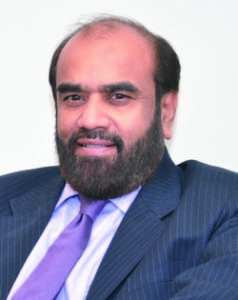Mahindra Finance today stands tall among the NBFCs in the country with an emphasized focus on rural finance. Ramesh Iyer, VC & MD of the company, who is passionate about the business model he developed, narrates the 22-year-old journey he undertook in 1995

From one branch and a couple of customers in 1995 to 1400 branches and 4 million plus customers today is the transformation narrative of Mahindra Finance, by far the No 1 NBFC in the country with a committed objective of changing the lives of semi-urban and rural India through affordable and customer-centric financial solutions. “It has been a phenomenal journey for us through these 22 years,” says Ramesh Iyer, VC & MD, who converted the organization from just four people in the staff to some 27,000 people now on the rolls and from a balance sheet of Rs 50 crore to begin with to nearly Rs 6300 crore in 2016-17. Its total assets today are nearly Rs 50,000 crore.
Iyer has delivered more than what he had set out to do when the company was founded with the intention of helping Mahindra & Mahindra sell its utility vehicles. From being a captive finance company, it has matured to become India’s largest non-banking finance company in the semi-urban and rural areas, perhaps larger than some of the private sector banks in the country.
“Today, we are in every state. Through our branch network, we are close to covering upward of 85% of the districts in the country. More importantly, we have cumulatively financed close to 4 million plus customers, over this period of time. Actually, when we track our customers, we can spot them in 330,000 villages in the country, which is one in 2 villages. That is the reach we have built,” says Iyer.
What is more gratifying for him is the fact that in 1995, the operations of the company began with 4 employees: “It was me and my colleague V. Ravi, who is now the Executive Director and CFO, and two office assistants. Today, we are close to 27,000 people across the country. We began as a captive finance company for funding Mahindra utility vehicles and subsequently tractors, but today we finance all kinds of vehicles – about 45% to 47% of the balance sheet is Mahindra vehicles and 50% to 55% is non-Mahindra vehicles. This means we have built a business model, which has become hugely customer centric and customer accepted. This is how we have been able to build a business with a rural focus.”
RURAL-CENTRIC
Iyer recounts how Mahindra Finance developed its rural focus: “As I mentioned, we started as a captive finance company initially to finance the Mahindra range of vehicles. At that time, we did not envisage tractor finance at all but only financing of the Mahindra utility vehicles, which were predominantly sold in the rural markets of India. So, by design, we had to go out to the rural market and start understanding the opportunities and challenges. One thing we knew was that in rural India there were two sources of finance possible. One was the banking system, which comprised the nationalized banks and the cooperative banks, and the other was the money lenders. In such a situation, we had to first decide what we should do. Anyway, we decided we will finance vehicles, and we opened our first branch in Jaipur, the reason being one of the board members, who happened to be a dealer, hailed from Jaipur and he suggested we start from that city.”
EARN AND PAY MODEL

Ramesh Iyer believes that there are 3 strong pillars that help businesses to grow – people, liquidity support and technology
As the company began operations, the initial learnings came from the customers themselves. The first realization was that most of the customers did not have bank accounts and therefore no financial statements. There was no method to assess the credit risk of these customers. Secondly, the vehicles that were being bought were actually being used commercially, either to carry people, or to transport goods. During the interactions, these customers, Iyer says, convinced the company that if they take these vehicles, they will earn from the use of the vehicles and repay the loans. “So, it was an ‘earn and pay’ business model unlike the traditional model where the customer had the money to repay the loans through an already fixed cash flow,” he adds.
“The real challenge was to understand how much he can earn from this vehicle, how much will be the cost of the operations and what are his own personal requirements from the earning and therefore how much surplus would he be able to generate to repay loans,” says he.
LOCAL STAFF
“There was another challenge we faced then,” says Iyer, “that is, who should be the employees who would service these customers. We realized that we cannot recruit people from the cities and send them across, firstly because they will not have the understanding of the rural market. Secondly, they may not be willing to stay in the countryside. And thirdly, they should be able to speak the local language and understand the local challenges. Besides, they must have a local connection so that they have the support of the social system. So, we consciously decided to recruit people from local colleges rather than appointing people from cities or towns. This was the second strategic approach we took.”
The third challenge was the fact that a customer is earning almost on a daily basis and he does not have a fixed income pattern. He may be able to repay the loan either daily or he can keep the money in safe custody and pay once a month or once in a quarter. But, the important question is whether he will come all the way from his village to the company’s branch to make the payment.
PROXIMITY WITH CUSTOMERS
“So, we found that the solution lies in opening more branches to be closer to the customers, to create proximity with customers. And we needed this proximity for two reasons – to enable the customers to come and pay or for us to be able to go and collect the money from them and secondly, in case he fails to pay, then we should know the reason for his doing so. Because, in this kind of business, it is extremely important to identify the difference between circumstantial failure and intentional failure. If it is a circumstantial failure, say due to poor earning, or the vehicle giving problems or the monsoons failing his business, we felt that we need to partner with the customer and try and give solutions. But, if the customer is earning and he is diverting funds towards some whims and fancies, or personal aspirations, at the cost of not paying the instalments, then these are intentional defaults that need to be handled differently. So, from both these angles, we were required to be close to the customers,” says Iyer.
The fourth challenge, according to Iyer, was communication. How would a branch office communicate with the head office on what is seen on the ground? “We at the head office needed to decide on the product design and channel requirements, training and understanding the customer. In 1995, technology was not very developed in order to address this issue. There used to be substantial telephone communications between the branches and the head office. It was all about on-the-field information collection and knowledge sharing. It was an important ingredient in the strategy,” he says.
“So, if you look at how the business has actually grown, it is from bottom up on the ground, interaction with customers and better product design, which specifically suits the customers and their cash flow. That is how we conceived and developed the whole business model. It is a very customer-centric model. It is not a standard model where I will say I have this model and this customer. Different states have different challenges and different requirements. So what works for us in Kerala may not work for us in Odisha. It became important that this has to be an extremely decentralized business, it has to be a highly people-oriented business, it has to be a highly customer interactive business. Beyond everything, it has to be a highly flexible business that can keep bringing in the learnings from the market to create new products and develop channels and people capability. That is how we actually grew in this business,” points out Iyer.
TRACTOR BUSINESS
Very soon, the company added tractor finance to its portfolio. Iyer says it had a very different set of challenges. The customers may buy tractors anytime during the year, but the loan repayments were linked to the farming cycle. The cash flows would ideally be in November-December or in February-March. There is no question of regular daily or monthly or quarterly cash flows. The customers therefore started asking for either quarterly or half-yearly repayment schedules and also payment holidays during the lean months like June, July etc. But the problem with this repayment cycle was that if one season was good for the customers and they could afford to pay, there would be another season which would be bad and there could be defaults. The overdues in such cases would become very large. It became even more important for the company to understand and build relationships with the customers at a very local level.
“So, we had to open branches even at deeper pockets and we had to be closer to customers at the village levels,” says Iyer.
INTENTION TO REPAY
One thing that distinguishes the rural community, according to Iyer is that the intention to repay is extremely high. The measurement of the intention, according to him was: one, whenever the customer is not able to pay, he will invariably come forward and explain the reasons and circumstances for the failure; and two, when the company’s representatives go and meet the customer, there will be no effort on their part to hide or stay away. Even the family members will be aware of the problems and will explain the reasons and circumstances for the non-payment. While the customer himself will be available for discussions, the assets on which the finance was provided would also be made available to be seen by the staff. He will have no intention to hide the assets or sell them. Basically, the intention to cheat is very low.
CAR FINANCE
As years passed on, the business has grown real big. And it became imperative that there should be other lines of business. Soon, the company got into car financing, because the next big product that was getting sold apart from utility vehicles and tractors was cars. And the company felt that Maruti Suzuki was a good partner to work with because it had also built penetration and a good dealer network. The first car financing was for the Maruti range of vehicles.
OTHER BUSINESSES
While financing utility vehicles and tractors got stabilized, Iyer says the company looked at other possibilities that could utilize the efficient channel network and the customer base that were created. The first opportunity was the creation of Mahindra Insurance Brokers Limited. It began as an agent for one insurance company, but when the company reached out to the customers, it was found that they were wanting options. So, it decided to offer products of several companies.
Says Iyer: “Why insurance broking was chosen was that we realized that all our customers required some kind of a life cover because most of the vehicle owners were owner-drivers. In case something was to go wrong, the whole family would suffer. So, we discussed and decided that we need to come out with an innovative product rather than a standard one. That was the first time that we started discussing with Om Kotak and we developed and introduced a product called ‘Loan Suraksha’. It is an innovative insurance product in that we insured the life of the borrower, and the value of the insurance is equivalent of the value of the loan we had extended. So, if something was to go wrong with the customer during the loan period, the customer’s family could decide either to take the vehicle or take the claim. In the latter case, the finance company gets to take the vehicle. It was well programmed that the customer’s family is protected, the finance company is protected and the insurance company gets business.”
Started as a very small synergized business, it has grown with a business volume upward of Rs 175 crore. It is making a profit after tax every year of Rs 50 crore plus. And the unit has kept pace with the growth of Mahindra Finance with branches in almost every state. It has a separate team of about 1000 people and there are sales arrangements with all the life and general insurance companies for distribution of their respective products.
HOUSING FINANCE
“Then, we looked at the other requirements of our target customers from a financial perspective,” says Iyer. “The first thing that we came across was the fact that many of the houses in rural India are in semi-finished condition. The owners often did some renovation from time to time depending on their cash flow – say during a good crop season. If the next season fails, the work remains unfinished. They did not know where they can get finance to complete the work. We spotted this as an opportunity and set up a business called Mahindra Rural Housing Finance Ltd.”
The company does not finance construction of large houses, but provides funds for home improvements or repairs. Interestingly, the ticket size of the loans required was in the range of Rs 1 lakh to Rs 1.5 lakh on an average and the tenure could be anything between 3 to 7 years. “We believe this is a most socially impacting project with a huge potential,” says Iyer, adding: “In the space of less than 10 years that we are in this business, we are already in 12 states and are running a balance sheet of upward of Rs 5000 crore and a very profitable business. What is interesting is that because of the rural focus of the business, the National Housing Bank (NHB) has taken a shareholding of 12.5% in this venture. The company has built a very large customer base of upward of about 5 lakh and is present in some 50,000 villages in the country. In 2016-17, its PBT was at Rs 126 crore.”Iyer believes that this business has a great potential and can reach a level of Rs 20,000 crore in about 5 years. In addition to village-based housing finance, it has also entered the semi-urban lower middle-class housing finance business. Currently, about 15% of the business comprises low cost and semi-urban housing finance. Again, the focus will be beyond the metro market and looking at ticket sizes of Rs 7 to Rs 10 lakh and for people who are either local professionals, or those working in local factories, local dealerships etc. “We will look at their cashflows and will design products to suit their individual requirements and their capacity to service the loan. We strongly believe low cost affordable housing is the next phase of growth and has lot of scope and we may be able to look at schemes like PMAY, CLSS to address ‘Housing for all by 2020’. I think this business – rural housing and low-cost housing together – can scale up to a level of Rs 20,000 crore plus,” says Iyer.
JOINT VENTURE IN US
All is not rural with Mahindra Finance. In fact, it has a diagonally different approach when it set up a joint venture in the US. The idea came from the fact that Mahindra & Mahindra sells a large number of tractors, especially in the US. So, Mahindra Finance joined hands with a subsidiary of Rabobank called DLL. Interestingly, 51% of the investment is by DLL and 49% by Mahindra Finance, but the company is called Mahindra Finance USA. The company has built a balance sheet of almost $1 billion and it gives a return of upward of 10% to 12% on equity and has been one of the most successful ventures.
Says Iyer: “We believe as we go along we will look at other international markets along with our partners. To start with, we may look at markets like Brazil, Mexico and Canada. We are also actively in dialogue to see whether we can look at Africa as also the markets just adjacent to us like Bangladesh, Nepal, Myanmar, Sri Lanka, etc. Our international foray is clearly going to be to follow the footprints of Mahindra & Mahindra. We will look at two angles – one partnering with our current partners and see which are the markets they are interested in and whether we can set up shop there and secondly exploring adjacent markets in neighboring countries where we think that we will have a better understanding of the profile of the customer and our ability to design products for these markets. Our approach would be to look for some local partners who would be willing to join us. Mahindra & Mahindra has strong dealers in all these markets and they themselves are interested in looking at finance company options and we may look at partnering with them and setting up joint ventures. This will be our international foray.”
AMC
The latest venture that has been initiated is an asset management company, Mahindra Asset Management Company. Strategically, the company believes its strength is rural. Says Iyer: “An asset management company cannot afford to ignore the size of the urban market, but our strength, our ability and our intention and strategic intent would always be to grow in the semi-urban and rural market. When we surveyed the rural market, we found that many of the rural customers have surplus funds, which they usually deposit in products like fixed deposits of banks or buy gold or land. When we look at the average age of the rural population, it is getting younger and when we look at the other options for them to invest, the input that we got was that they are willing to look at other investment products. As regards mutual funds, 80% plus of the mutual fund gets collected from the urban markets. So, we feel here is another opportunity to innovate certain products and communicate the details to the rural population so that they have an opportunity to be participants in the growth. We got the license for the AMC and regulatory approval for specially designed products, which are very rural-specific or rural-flavored. The details of these products are very easy to communicate to the rural population. They are small ticket products and rural cash flow-based. This business is less than 3 years old and it has done very well for us with a book close to Rs 3000 crore. Interestingly, we cannot ignore the urban customers. We have been able to mobilize funds from large corporates but large retail business has come from rural India.”
So, the journey that began in 1995 when the four people set out to reach rural India, aiming to provide specially designed financial products for them, has come to stay. In these 20-plus years, the company has been able to develop a strong rural penetrated financial inclusion model, which is completely based on creating and developing products and services and delivering them through a locally built channel and through a large network of locally recruited employees. This, feels Iyer, is the true financial inclusion story that the company has created.
NPA ISSUE
“When we look back and ask ourselves about the challenges we face in spite of all the experiences and knowledge we have gained, I would mention that the customers continue to rely on their cash flows which have lot of vagaries – like the monsoon, or local issues. We have different periods of cyclic impacts – like if the monsoon does not do well in certain markets, the customer cash flows do suffer, or for that matter when both the monsoon and infrastructure story does not do well in certain pockets, the customer suffers even more. We have had some testing situations where our gross NPAs had really climbed very high, even crossing the 10% mark. But, a very important and salutary point to be understood is that these are not intentional defaults. Once the season starts correcting, we collect back all our money that is due and provided for. We had a situation in 2009-2010, when the gross NPA crossed the 10% mark, but in the next season or 2 seasons after that, when the market conditions improved, the NPA levels came down to as low as 3%. The money does indeed come back. We faced a similar situation in 2014-15 and 2015-16, when the monsoon failed in many states, the infrastructure at certain geographies was not promising and there was the impact of demonetization. This led to our gross NPAs going up. Now, if you look at the last two quarters, we have seen substantial improvement in growth returning and past provisions coming back,” says Iyer.
He emphasizes that this is a model where one needs to have tremendous patience. One needs to have deep penetration, one needs to have phenomenal passion for the work that is being done and an affinity towards a very home-grown process. Above all, it requires a very well-defined product based on customer ability and cash flow, which are very market related. “If you have all these ingredients, and you deliver through people who are well trained, I think this is a great business model which may see its ups and downs during certain seasons, but on a portfolio basis or on a consistent growth basis, it is a high return model. If you look at our 20-year history, we have had a compounded annual growth rate of upward of 25%; if you look at our net worth, from a small base, it has grown into a large net worth of Rs 8000 crore. We are close to $300 billion to $400 billion market cap,” says he.
3 PILLARS
Iyer believes that there are 3 strong pillars that help businesses to grow – people, liquidity support and technology. “As far as technology is concerned, our focus has always been two-fold: one how do we continuously bring costs under control so that the customer can benefit and two how do we ensure that such a large business, widespread at the retail level across the country does not have any control weaknesses. At the end of the day, it is a very highly regulated business and we need to ensure that everything that happens at every branch is very well understood and meets all the regulatory and audit requirements. Therefore, control becomes critical. The third element of the business also comes from a highly efficient CRM system as well as a strong MIS base. Keeping these in mind, we have invested adequately and continuously in technology all the time. This is a very unique business where initially – 1995 to 2000 – almost 100% of our collections were coming in cash. And over a period of time because of the mix of customers, cash collections accounted for 65% to 70%. This is then deposited into thousands of bank accounts all over the country. Against this, the customer profile is not that literate. They always look at the safety and security of the cash transactions. So, when they make an instalment payment, they want to make sure that the payment is duly given to the authorized person, it is duly acknowledged and the payment is reflected in their statement of accounts, simultaneously as a credit. We could meet this fundamental requirement right from our initial days in business.”
TECHNOLOGY
He points out that Mahindra Finance was the first financial services company in the country to introduce handheld devices whereby when the staff reaches out to a customer and collects his instalments, he is given instant receipts irrespective of the location. The cash gets deposited in the bank and gets accounted without any manual intervention. The receipt is cut through the handheld device and this is automatically accounted for in the system. So, the customer felt hugely comfortable about the processes.
Iyer also maintains that over a period of time, the company has become a very live one – that is one can sit say in Mumbai and see the transactions live happening say in Nagercoil in Tamil Nadu.
“Over a period of time, we have put in all the knowledge of this business and converted it into a technology solution and all the MIS we get are highly analyzed for people at every level to access and take appropriate decisions. But, the overall approach of the technology intervention has a strong two-fold approach – one how do you bring down the cost of operations because of the large nature of the operations, and two how do we not lose control. We have achieved both these objectives phenomenally well. We have also built a strong customer relationship management module. There are repeat customers today upward of 15% to 20% every month through our direct marketing initiatives. And that is one of the outcomes of this technology intervention,” he points out.
The company is now moving to the next phase of technology updation, which is using the digital platform to give various options to the customer. He can borrow through the digital platform, or make repayments. The company has also entered into tie-ups as a partnership approach with payments banks or payment facilitators and other service providers through which the customer can be serviced.
Iyer says the next phase will come from analytics. “, We have over 4 million customers today and are adding 50,000 new customers every month. This is a great scope for analytics. With 20 plus years of experience, of 20,000 odd people collecting information about customers through market interventions, I think the knowledge and data that has become available has fantastic ability to create many more such innovative products for the customers specifically meeting their needs and many such channels to deliver these products and other services at a very affordable price. More importantly, we are now in a position to really set out and forecast trends of who will buy what, when, why and through whom and how. We are actually moving away from a purely sales fulfilment organization to a sales generating and converting organization with the help of the large data and vast knowledge and active interventions through technology platforms. This is our technology approach and you will see us as really leading the technology change that will happen in rural India alongside the several government initiatives to create various digital means and platforms.”
EMPLOYEE-INVOLVED CSR
Having built such a large business, the company has always looked at how it can contribute back to the community and society through a sustainability approach and through its CSR initiatives. Apart from the fact that there is a need for investing 2% of the profit in CSR initiatives, what the company has looked at as investment and contribution back to society is to meaningfully deploy these funds rather than just donate money to an organization. “Our approach in this regard is to involve the entire employee community along with the funds that are made available. We chose certain projects under the larger heading of health, education and environment and ensure that these are really designed and delivered at the rural level so that the ultimate beneficiaries are the families in rural India. It is not necessary that the funds are routed through some intermediaries on whom we may not always have control. Therefore, we have set up a team purely focusing on CSR activities and we have some flagship programs like driver training, financial literacy programs, Life Line Express for rural village population and providing ambulances to very deserving rural health clinics and hospitals. These are our approaches where apart from the beneficiary being the local population we look for utmost satisfaction for the doer of such activities,” says Iyer.
So, the employees – almost 65% to 70% – actively participate in these activities. Iyer says that gives him the ultimate satisfaction apart from growing a business into a large size. Similarly, on the sustainability front, the company is trying to make branches move to solar-based system wherever possible and undertake tree plantation across the country. “Above all of these, what we try and encourage is to ensure that employees and their families participate in these initiatives as much as possible. This is how we ensure that we contribute back to the society,” says Iyer.







